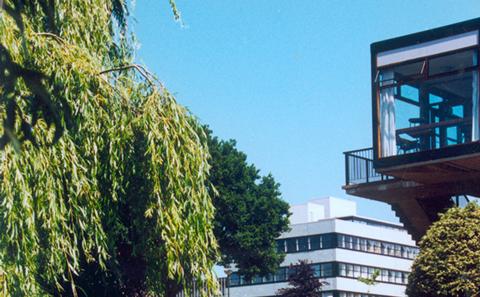Accreditation
Our aeronautics and astronautics courses are accredited by the Institution of Mechanical Engineers and the Royal Aeronautical Society and offer you a route to chartered status.
The MEng Aeronautics and Astronautics fully meets the academic requirement for registration as a Chartered Engineer.
Programme Structure
The University uses the European Credit Transfer Scheme (ECTS) to indicate the approximate amount of time a typical student can expect to spend in order to complete successfully a given module or programme. 1 ECTS indicates around 20 nominal hours of study. Previously, Credit Accumulation and Transfer Scheme (CATS) points were used for this purpose where 1 CATS credit was 10 nominal hours of study. You will study modules comprising 120 credits (60 ECTS) for all four years. Each module is a self-contained part of the programme of study and carries a credit rating.
Should you choose to exit this programme after successfully completing three years of study, you will be eligible for a BEng qualification. The BEng route develops the same core skills as the MEng, however by choosing the MEng you will study a more extensive range of subjects at an advanced level.
Changes due to COVID-19
Any future COVID-related restrictions could mean we might have to change the way parts of our teaching and learning take place.
We are working hard to plan for a number of possible scenarios. This means that some of the information on this course page may be subject to change.
Key Facts
- You will work on design activities that relate theory to practice and combine analytical skills and creativity in the solution of real engineering problems.
- A group aircraft (or spacecraft) design exercise is completed in Year 3.
- In Year 4, you will participate in a Group Design Project (GDP). These projects are often linked to current research activities or topics that have practical relevance to industry.
Typical entry requirements
Entry Qualifications for Undergraduate Courses
| Award |
Qualification |
| A level |
A*AA including Mathematics and Physics, with a pass in the Physics Practical (where it is separately endorsed) |
| IB Diploma |
Pass with 38 points overall, 19 points required at Higher Level, including 6 at Higher Level in Physics and 6 at Higher Level in Mathematics (Analysis and Approaches) or 7 at Higher Level in Mathematics (Applications and Interpretation). IB English: 5 at Standard/Higher Level in IB English Language Syllabus A or 6 at Standard Level/5 at Higher Level in IB English Language Syllabus B. |
| STPM |
AA-A-, including Mathematics and Physics |
| UEC |
AAAAAA, with A in Advanced Mathematics I & II, Physics and two other STEM subjects (Computing accepted)* |
| Foundation Year |
Foundation Year programmes from the other institutions will be considered on a case-by-case basis |
Other equivalent qualifications (including international qualifications) will be considered, please contact a UoSM education counsellor or your preferred agent to understand more
*For UEC students who did not meet the typical entry requirement but obtained a Grade A in Advanced Mathematics and/or Physics with other STEM subjects scoring at least a Grade B are encouraged to apply.
English level requirements
IELTS 6.5 overall, minimum 6.0 in all components or Grade C in SPM 1119 English (cohort before 2021), SPM CEFR Level B2 or above (cohort from 2021 onwards), Grade C in GCSE English, Grade A in IGCSE English as a Second Language, B3 in UEC English or equivalent.
Please CLICK HERE for the current English language requirements, a list of qualifications and tests the University of Southampton recognises and a list of exempt countries.
Contextual offers
The University of Southampton is committed to widening participation and ensuring that all students with the potential to succeed, regardless of their background, are encouraged to apply to study with us. The additional information gained through contextual data supports our admissions teams to recognise a student’s potential to succeed in the context of their background and experience. Students who are recognised in this way will be made an offer which is lower than the typical offer for that programme.
A typical contextual offer is AAB (AA in Mathematics and Physics with a pass in the Physics practical) from three A levels or an equivalent standard in other qualifications approved by the University.
Please see our contextual admissions pages for more information.
Selection process:
As well as 'A' levels (as awarded in the UK secondary education system) we will accept an equivalent standard in other qualifications approved by the University for entry to our courses.
This page contains specific entry requirements for this course. Find out about
equivalent
entry requirements and qualifications for your country.
Typical course content
The first two years of our courses provide a solid, focused, foundation for the design and operation of air vehicles and spacecraft. You will follow a core set of modules before specialising in your chosen area in the third and fourth years.
Please note: This specification provides a concise summary of the main features of the
programme and the learning outcomes that a typical
student might reasonably be expected to achieve and demonstrate if s/he takes full advantage
of the learning opportunities that are provided.
More detailed information can be found in the programme handbook (or other appropriate guide
or website).
Tuition fees
MEng Aeronautics and Astronautics
| Year of Study | Mode of Study | Malaysian | International |
|---|
| 2023 |
Full-time
|
RM51,700/annum
(Year 1 & 2) |
RM 59,950/annum
(Year 1 & 2) |
RM 107,000 (£20,000)/annum
(Year 3 & 4)* |
*Students completing Years 1 and 2 in Malaysia are entitled to a Special 20% Transition Bursary for Years 3 and 4. The above tuition fee calculation has considered this 20% bursary.
Scholarships and bursaries are available at the University of Southampton Malaysia.
Funding opportunitiesCosts associated with this course
Students are responsible for meeting the cost of essential textbooks, and of producing such
essays, assignments, laboratory reports and dissertations as are required to fulfil the
academic requirements for each programme of study.
In some cases you'll be able to choose modules (which may have different costs associated
with that module) which will change the overall cost of a programme to you. Please also
ensure you read the section on additional costs in the University’s Fees, Charges and
Expenses Regulations in the University Calendar available at www.calendar.soton.ac.uk.
Pathways
In parts one and two, you will study core Aeronautics and Astronautics topics to give you a strong foundation in the subject. In parts three and four you can follow an interdisciplinary programme or choose to specialise in one of the following pathways (themes):
Aerodynamics
This programme will give you the knowledge and skills to analyse and control aerodynamic behaviour. You'll learn how to design vehicles, wings and propulsion systems. The course prepares you for a career in the aerospace or Formula 1 industries.
This pathway focuses on the aerodynamics of vehicles, wings and propulsion systems.
For a list of modules available for parts 3 and 4 please see the UK course page.
Airvehicle Systems Design
Learn to design helicopters, fixed-wing aircraft, and their avionic systems. You’ll study many aspects of aerospace engineering, including the design and manufacture of fast-moving aircraft and spacecraft, before specialising on their systems, performance and optimisation requirements. This course is ideal for a career in air vehicle design.
This pathway will focus on modules specialising in advanced air vehicle systems, avionics and design.
For a list of modules available for parts 3 and 4 please see the UK course page.
Computational Engineering Design
Discover how to use computers to help model and optimise aeronautic and astronautic designs. You'll learn how to research and solve new aerospace challenges, with a focus on computational methods.
This pathway will focus on computational engineering, which is a core skill to help aerospace engineers optimise their designs.
For a list of modules available for parts 3 and 4 please see the UK course page.
Engineering Management
Study aerospace design while learning how to manage its processes, people and finances. You’ll explore many aspects of aerospace engineering, including the design and manufacture of fast-moving aircraft and spacecraft, before specialising in strategy and project management. This course aims to help engineers quickly progress into key positions in the aerospace industry.
This pathway will focus on more advanced modules specialising in business strategy, finance, and managing people and projects.
For a list of modules available for parts 3 and 4 please see the UK course page.
Materials and Structures
Learn about the materials used in aircraft and spacecraft, why they’re chosen, how they behave and why they sometimes fail. You’ll study the design and manufacture of fast-moving aircraft and spacecraft, then specialise in their materials, structures and analysis. This course will prepare you for a career in engineering design or further research.
This pathway will focus on more advanced modules in materials, construction and testing.
For a list of modules available for parts 3 and 4 please see the UK course page.
Spacecraft Engineering
Take your engineering abilities to the final frontier of human endeavour. You’ll explore many aspects of aerospace engineering, including the design and manufacture of fast-moving air and space vehicles. You'll then specialise in spacecraft systems engineering, to prepare you for a career in the space industry and beyond.
This pathway will focus on more advanced modules specialising in the design and operation of spacecraft, and their environmental impact.
For a list of modules available for parts 3 and 4 please see the UK course page.

